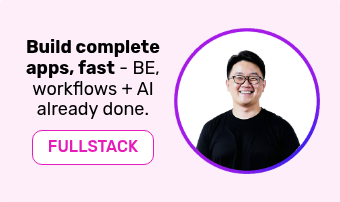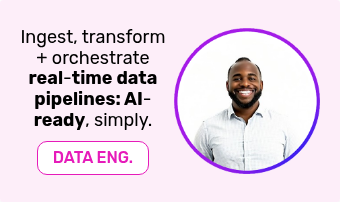In the realm of business operations, the adoption of IoT platforms is a strategic move that can transform business processes and outcomes. However, making a compelling business case for this technology requires a deeper dive into the financial and operational benefits it promises.
This article guides you through the detailed process of constructing a solid business case, encompassing various financial calculations and considerations.
The steps for creating the business case for a full-stack, low-code IoT platforms:
1) Define Objectives and Scope:
- Identify the business problem you're trying to solve.
- Clearly define what you aim to achieve with the platform.
- Outline the boundaries of the project including which areas of the business it will impact.
2) Conduct a Needs Assessment:
- Assess the existing systems, processes, and capabilities.
- Describe how the hybrid iPaaS, integration, Data, AI, IoT and PaaS platforms will change operations and outcomes.
3) Identify Benefits + Opportunities:
- Operational, (efficiency gains, process improvements, reduction in downtimes, etc.), strategic (enhanced decision-making capabilities, competitive advantages, market opportunities), and financial (cost savings, revenue growth, ROI etc.) - more on all this below.
4) Analyse Costs:
- Initial: Acquisition, implementation, training, and any transitional costs.
- Ongoing: Operational expenses, maintenance, upgrades.
- Indirect: Potential risks, opportunity costs.
5) Perform Risk Analysis:
- Identify risks, including technical, operational, and financial.
- Assess the probability and potential impact of each risk.
- Plan for risk mitigation and management.
6) Develop Financial Model + Projections:
- More on this later (see below).
7) Gather Qualitative Data:
- Get stakeholder feedback and input from potential users, management, and external stakeholders (where appropriate).
- Look at industry trends, competitor analysis (if you have any), and also what the market looks like (this article might help: Top IoT Platforms: A Quick Guide).
8) Create Implementation Plan:
- Outline the steps for implementation, including timelines and milestones.
- Plan for the necessary resources - human, technological, and financial.
- Outline the strategies for training employees and managing change.
9) Document and Present the Business Case:
- Assemble all data, analyses, and strategies into a comprehensive document.
- Create an Executive Summary, which highlights key points and value proposition.
10) Review and Update:
- Regularly revisit the business case to ensure it remains relevant and accurate.
- Adjust the business case based on new information, changing conditions, or project progress.
Identifying the Key Benefits:
Building the business case requires you to identify the specific benefits that the platform will bring to your organisation, which can be challenging for novel technologies.
These benefits can vary based on your unique operational needs but generally include cost savings, efficiency/wastage improvements, revenue/production growth, and risk mitigation. For instance, cost savings may be realised through reduced downtime and lower maintenance costs, while efficiency improvements could be seen in reducing energy usage or decreasing things like carry-back or product wastage.
Our advice here would be, even though the platform can do anything and be applied to multiple use cases, focus on one. This not only makes it (a lot) more straightforward, but increases stakeholders, investment needs, and makes it far more likely to get a project off the ground. You can always come back to or tease additional stages and roll-outs, but treat each one separately, and if you can prove ROI from the first, the rest will be simple!
- Calculating Cost Savings + Efficiency Gains: To quantify cost savings and efficiency gains, you'll need to analyse current expenditure and operational metrics. This involves assessing things such as maintenance costs, downtime expenses, and labour costs associated with current processes. The hybrid platform's impact can be quantified by estimating the reduction in these costs. For instance, calculate the cost of downtime per hour and multiply it by the expected reduction in downtime hours; or for, something like remote monitoring of a weather station, implementation means that someone doesn't need to visit it frequently to make sure it's working ok, so calculate the fuel and man hour savings.
- Projecting Upside: Revenue growth can be trickier to quantify but can be approached by evaluating the platform's potential to improve efficiency and total output. Estimate the potential increase in production, sales or market share due to these improvements and translate this into revenue figures. An example of this could be, if you're reducing wastage by 5%, how many units does that translate into and what does it make for the total cost of production per unit.
- Assessing Risk: Risk mitigation involves calculating the cost implications of potential risks (like system failures or security breaches) and how the hybrid platform can reduce these risks. Assign a cost to each risk scenario and estimate the reduction in risk occurrence probability post-implementation. Likewise, this can also be applied to things like preventing environmental breaches and fines (pure bottom-line cost removal), or safety incidents (lost man hours, fines etc. associated with injury/death).
Creating a Comprehensive Financial Model.
Developing a detailed financial model can be a daunting part of formulating a business case as it's where the rubber meets the road and it mightn't be what you do on a day-to-day basis i.e. daunting.
Get a spreadsheet and start putting the numbers in there, when you start doing it, you'll se it's not as terrifying as you might think. It should outline the cost and benefit figures discussed above, as well as include these key metrics:
- Total Cost of Ownership (TCO) + Payback Period: Calculating TCO is crucial for understanding the long-term financial implications. Include initial acquisition costs, implementation costs, ongoing operational costs, and any potential savings over time, such as the removal of existing technologies that are made superfluous (e.g. platform consolidation - see this article for more: The Quick Wins from Integrated Data, AI + IoT Platform Deployments). This comprehensive view helps in evaluating the financial viability of the investment and will also enable you to assess the Payback Period, i.e. the time it takes for the benefits to offset the initial investment costs (a great score would be between 1-to-3 years).
- Return on Investment (ROI) Analysis: ROI analysis is a critical component of the business case. Calculate the ROI by dividing the net benefits (total benefits minus total costs) by the total costs of the platform. A higher ROI indicates a more favourable financial return on the investment. As a minimum, you're obviously looking for a positive number(!) but your expectations will be set based on the initial, as well as future use cases.
- Cost-Benefit Analysis (CBA): For CBA, evaluate the cost of investment against the expected benefits, as well as what the cost to the business is of doing nothing - these can be 2 separate numbers if needs be. Include initial setup costs, ongoing operational expenses, and anticipated savings or revenue enhancements.
Stop Trying to Create the Perfect Business Case!
Let's be frank, a lot of what goes into business case creation is educated guesswork. What's critical is that you quantify the current problem, are realistic about the headroom and projections for improvement, and can show your working - no-one wants to be held to unrealistic targets and you are the architect, so don't set yourself up for failure.
Business Cases also don't need to be 'War and Peace'! in fact, it's generally much better if they're not. What's needed will vary from business-to-business, so do what's necessary, but bear in mind that the Executive Summary is all that's likely to be read by nearly all involved.
Constructing a business case for an IoT platform that's hybrid and incorporates the features of iPaaS, integration, workflow automation, Data, AI and low-code app development platforms in one requires consideration of various financial and operational factors, but by methodically analysing cost savings, efficiency gains, revenue growth, risk mitigation, TCO, and ROI; you can present a compelling case that highlights the strategic value of this technological integration.
If you need help building your business case, getting the numbers together due to limited publicly available information, or would like to explore exactly Rayven will do for you; please reach out and speak to us - we'd love to help.




















































